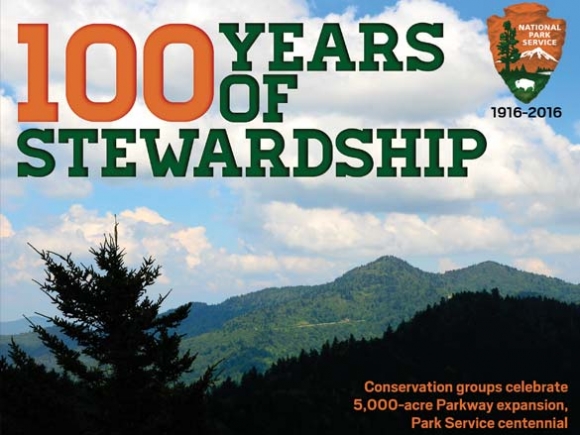National treasure: National Park Service celebrates 100 years

When President Woodrow Wilson scrawled the signature that brought the National Park Service into being — 100 years ago, on Aug. 25, 1916 — many of the parks now integral to America’s national identity had yet to be created.
SEE ALSO: Thousands of acres added to the Parkway for Park Service centennial
There was no Great Smoky Mountains National Park, no Blue Ridge Parkway, no Appalachian Trail. No Grand Teton or Olympic or Mammoth Cave or Acadia National Park. At the time Wilson signed the Organic Act, only 35 national parks and monuments existed, with America the only country to have any.
But an idea was enacted along with the legislation. A powerful idea. An idea that’s often called, “America’s best idea.”
The National Park Service, the act reads, will work to manage national parks, monuments and reservations in order to “conserve the scenery and the natural and historic objects and the wild life therein and to provide for the enjoyment of the same in such manner and by such means as will leave them unimpaired for the enjoyment of future generations.”
Today, the National Park Service manages 412 units covering more than 84 million acres. Worldwide, there are more than 1,200 national parks in 100 nations.
Related Items
And in Western North Carolina, a region that runs rich with both natural beauty and national park acreage, the words of the Organic Act have rung loudly throughout the 100 years unfolding since Wilson’s pen rose from signed paper.
In 1934, the Great Smoky Mountains National Park was created, an area that would eventually grow to cover 816 square miles, making it the largest national park east of the Rockies. Two years later, the Blue Ridge Parkway was added to the National Park System, with work on the 469-mile mountain road continuing through 1987, the bulk of it complete by 1966. While the Appalachian Trail also came about in the 1930s — it was completed in 1937 — it wasn’t added to the National Parks System until 1968, when the A.T. and the Pacific Crest Trail were added as the nation’s first two scenic trails under the National Trails System Act of 1968.
Now, on the 100th anniversary of the National Park Service, it’s not hard to find people willing to celebrate the milestone and speak to the importance of Western North Carolina’s national parks units — to both the region and the nation at large.
“We have been celebrating all year, so it feels good to finally reach the date that has been circled on so many of our calendars,” said Smokies Superintendent Cassius Cash. “This historic milestone for the Park Service has been an amazing opportunity to recognize and acknowledge our accomplishments, look to the future of our next century of service, and honor the over 340 employees who dedicate themselves daily to preserving and protecting Great Smoky Mountains National park.”
The Park Service has indeed been celebrating all year, launching the site www.findyourpark.com to give people a chance to share their stories and experiences at national park units across the country. Centennial-oriented events and initiatives have been in play throughout 2016, each park developing its own way to commemorate the centennial milestone.
“The National Park Service Centennial highlights the opportunities we all have — park staff and citizens — in ensuring these places and their stories are available for future generations,” said Parkway Superintendent Mark Woods.
For the Smokies, the Hike 100 Challenge was the big push. The challenge encourages people to log 100 miles of hiking on park trails by Dec. 6, after which those who complete the challenge will be invited to a celebration hosted by Cash. Cash himself, who came to the park in February 2014, is also completing the challenge, logging his miles during hikes organized with groups of youth representing demographics that are statistically unlikely to get much exposure to the outdoors.
“Through this shared experience I continue to discover what a special part national parks like the Smokies play in bringing people together as we disconnect from the busyness of our everyday lives and connect with each other along the trail,” Cash said.
National parks connect communities off the trail, too, with WNC’s mountain towns defining themselves by the natural beauty surrounding them and relying on the steady stream of tourists that the parks bring to bolster their economies.
In 2015, an estimated 10.7 million people visited the Great Smoky Mountains National Park, with visitor spending estimated to total $873.9 million and support 13,700 jobs. During the same year, 15.1 million people visited the Blue Ridge Parkway, with visitor spending estimated at $952.1 million, supporting 15,300 jobs along the Parkway’s length from Cherokee to Waynesboro, Virginia.
The Smokies are the most visited national park in the National Park Service, with the Parkway rated as the system’s most visited unit overall — the Park Service includes a variety of designations, such as “national monument,” “national parkway” and “national historic site,” among many others.
“Haywood County considers the Parkway our top tourist attraction,” said Lynn Collins, director of the Haywood Tourism Authority. “The variety of outdoor recreation activities available and the scenic beauty in Haywood County and its surrounding counties are the major reasons visitors frequent our areas.”
The national parks can be an economic engine for the communities around them. They can also serve as a memory factory for the people who visit them.
Mike Leonard, chairman of The Conservation Fund, can clearly remember the October day in 1969 when he and two good friends, then newly 16, camped out at Grandfather Mountain. They awoke to a clear, brilliant Saturday — the best of autumn in the mountains — and cruised all the way to Waterrock Knob. It was a pinnacle of memory, made all the more poignant by the fact that one of those young men would die in a car crash two weeks later. The day will forever be emblazoned in Leonard’s mind, the last time the three of them were together.
“It’s those kinds of memories that really make me so very passionate about this,” he said.
Most people who have spent time in a national park, he added, can tell a great story about an important moment that’s happened there. Add those walks down memory lane to the sheer beauty of the places and the ecological jackpot they comprise, and it’s easy to see why the Park Service centennial hits home for so many.
“They are the greatest idea — vision — that this nation gave the world,” Leonard said. “There’s no doubt about that.”
By the numbers
• 100 years since the National Park Service was created on Aug. 25, 1916
• 307.2 million visits to National Park Service units in 2015
• 412 units in the National Park Service
• 84 million acres in the National Park Service
• $873.9 million in estimated spending from Great Smoky Mountains National Park visitors in 2015
• 11 threatened or endangered species in the Great Smoky Mountains National Park









